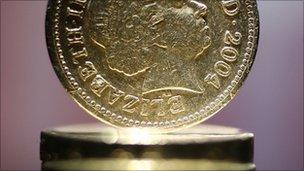Fake £1 coins rising in circulation, figures show
- Published
Nearly two million counterfeit £1 coins were returned to the Royal Mint in the last financial year, figures show.
This was more than 23 times higher than the number seized six years earlier, MPs were told.
An estimated one in 36 £1 coins in circulation are counterfeit, prompting a campaign by the Royal Mint telling people how to spot fakes.
Key signs of counterfeits include a poorly defined ribbed edge or an indistinct design of the Queen.
The UK Treasury said that the proportion of counterfeit £1 coins in circulation had only risen slightly in the last year. Attempts to tackle the number of fakes had led to the high number seized and returned to the Royal Mint.
"The increase in the number of counterfeit coins taken out of the system shows the success of decisive government action to tackle coin counterfeiting," said a Treasury spokesman.
"The government takes counterfeiting extremely seriously and over the past few years has been working closely with industry and law enforcement agencies to tackle this issue head on, with the Serious Organised Crime Agency successful in prosecuting counterfeiters."
Growing number
Various groups have been told to inspect for fakes before they reach the pockets of consumers.
In a written parliamentary answer, the Economic Secretary to the Treasury, Justine Greening, explained that high-speed automated systems were used by banks and the Post Office to process deposits and prepare coins for reissue.
"These automated systems are capable of detecting and withdrawing a significant number of counterfeit coins," she said.
"All counterfeit coins detected from coin processing are sent to the Royal Mint for disposal."
Financial institutions handled more than three billion £1 coins a year, she said.
In 2003-04, when figures were first collected, the number of £1 coins returned to the Royal Mint stood at 85,000.
This leapt to close to one million in 2008-09, and then doubled the following year.
In the first three months of the 2010 financial year, the number has already reached 187,000.
Spotting fakes
As soon as a coin accepted in good faith is found to be counterfeit, it is immediately rendered worthless. Attempting to pass it on is an offence.

Genuine coins have prompted attempted forgeries for many years
One way to identify a fake is to check the alignment of the coin. By holding it so the Queen's head is upright and facing you - when you spin it round, the pattern on the reverse should also be upright. Fakes can often be at an angle.
The Royal Mint's online design portfolio can also be used to easily identify what is genuine and what is not. Since they were introduced in 1983, the design on the reverse of the coins has changed every year.
The Royal Mint inspects a random sample of coins from across the country to establish the twice-yearly official forgery rate.